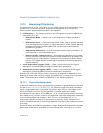
10-40 Vol. 3
ADVANCED PROGRAMMABLE INTERRUPT CONTROLLER (APIC)
ability for a processor to send a lowest prior-
ity IPI is model specific and should be avoid-
ed by BIOS and operating system software.
010 (SMI) Delivers an SMI interrupt to the target pro-
cessor or processors. The vector field must
be programmed to 00H for future compati
-
bility.
011 (Reserved)
100 (NMI) Delivers an NMI interrupt to the target pro-
cessor or processors. The vector information
is ignored.
101 (INIT) Delivers an INIT request to the target pro-
cessor or processors, which causes them to
perform an INIT. As a result of this IPI mes
-
sage, all the target processors perform an
INIT. The vector field must be programmed
to 00H for future compatibility.
101 (INIT Level De-assert)
(Not supported in the Pentium 4 and Intel
Xeon processors.) Sends a synchronization
message to all the local APICs in the system
to set their arbitration IDs (stored in their
Arb ID registers) to the values of their APIC
IDs (see
Section 10.8, “System and APIC
Bus Arbitration”). For this delivery mode,
the level flag must be set to 0 and trigger
mode flag to 1. This IPI is sent to all proces-
sors, regardless of the value in the destina-
tion field or the destination shorthand field;
however, software should specify the “all in
-
cluding self” shorthand.
110 (Start-Up)
Sends a special “start-up” IPI (called a SIPI)
to the target processor or processors. The
vector typically points to a start-up routine
that is part of the BIOS boot-strap code (see
Section 8.4, “Multiple-Processor (MP) Initial-
ization”). IPIs sent with this delivery mode
are not automatically retried if the source
APIC is unable to deliver it. It is up to the
software to determine if the SIPI was not
successfully delivered and to reissue the
SIPI if necessary.


















